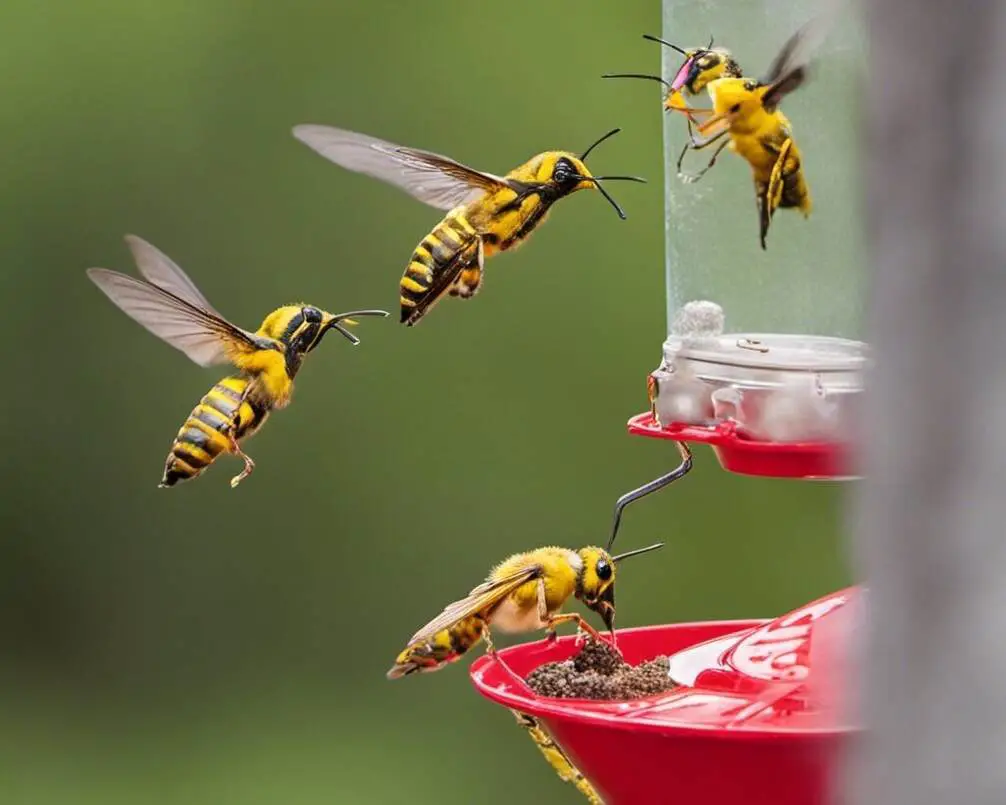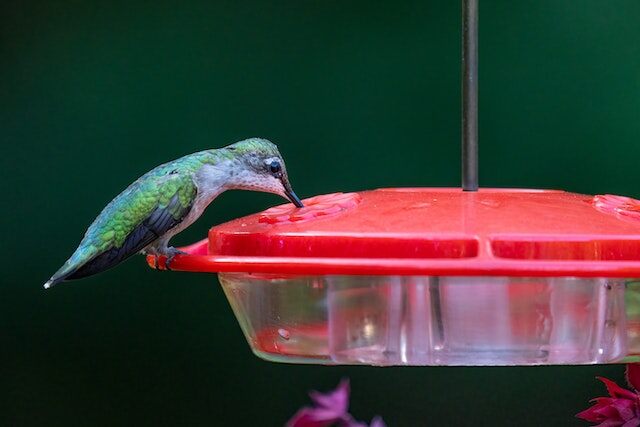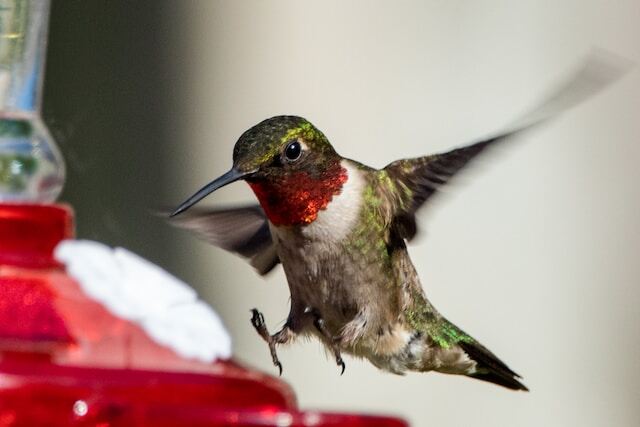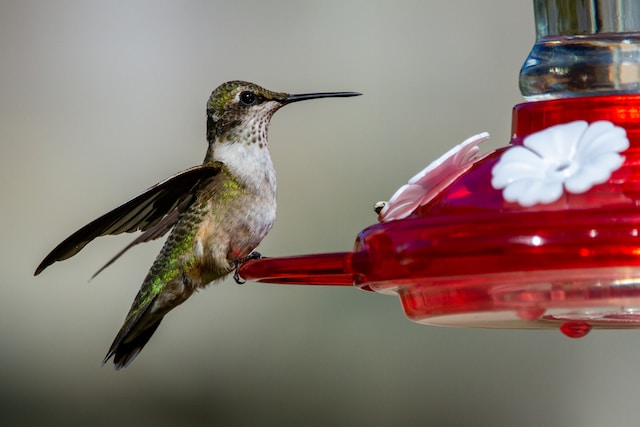Hummingbirds are a joy to watch, but they can also attract unwanted guests such as yellow jackets. These aggressive wasps can not only be a nuisance but also pose a threat to humans. However, there are effective strategies that you can implement to keep yellow jackets away from your hummingbird feeder.
Table of Contents
- 1 Key Takeaways:
- 2 How to Keep Yellow Jackets Away from a Hummingbird Feeder?
- 3 Understanding Yellow Jackets and Their Behavior
- 4 Choose the Right Hummingbird Feeder Location
- 5 Opt for a Yellow Jacket-Proof Feeder Design
- 6 Use Natural Repellents and Traps
- 7 Maintain Proper Feeder Hygiene
- 8 Avoid Using Insecticides Near the Feeder
- 9 Create Distractions for Yellow Jackets
- 10 Encourage Natural Predators
- 11 Seal Potential Nesting Sites
- 12 Stay Calm and Avoid Provoking Yellow Jackets
- 13 Conclusion
- 14 FAQs: How to Keep Yellow Jackets Away from a Hummingbird Feeder
- 14.1 What are yellow jackets?
- 14.2 Why do yellow jackets become a nuisance around hummingbird feeders?
- 14.3 Where should I place my hummingbird feeder to deter yellow jackets?
- 14.4 What is a yellow jacket-proof feeder?
- 14.5 Are there natural repellents and traps that can deter yellow jackets?
- 14.6 How often should I clean my hummingbird feeder?
- 14.7 Can I use insecticides near the hummingbird feeder to eliminate yellow jackets?
- 14.8 How can I create distractions for yellow jackets?
- 14.9 How can I encourage natural predators of yellow jackets?
- 14.10 How can I seal potential nesting sites to prevent yellow jackets?
- 14.11 What should I do if I encounter yellow jackets near my feeder?
- 15 Author
Key Takeaways:
- Yellow jackets are attracted to the sweet nectar in hummingbird feeders and can become a nuisance around them.
- Effective strategies to keep yellow jackets away from a hummingbird feeder include choosing the right location, using a yellow jacket-proof feeder, using natural repellents and traps, maintaining proper hygiene, and avoiding harmful chemicals.
How to Keep Yellow Jackets Away from a Hummingbird Feeder?
If you want to keep yellow jackets away from your hummingbird feeder, there are several methods you can try. First, you can hang the feeder in a location that is not easily accessible to yellow jackets. You can also use a feeder with bee guards or other barriers that prevent insects from reaching the nectar.
Removing any sources of food or garbage that may be attracting yellow jackets to your yard is also a good idea. If you need to use a trap, you can create your own using a small jar filled with a sweet liquid. However, it is important to place the trap away from the hummingbird feeder to avoid attracting other beneficial insects.
While yellow jackets can be a nuisance, they also help control other pests, so it is best to try non-lethal methods to keep them away from your hummingbird feeder.
Understanding Yellow Jackets and Their Behavior
Before we dive into the effective strategies to keep yellow jackets away from hummingbird feeders, it’s important to understand their behavior and habits. Yellow jackets are aggressive wasps that are often drawn to sweet substances, including the nectar in hummingbird feeders. They are attracted to bright colors and strong scents, and can become a nuisance around your feeder, potentially driving away hummingbirds and stinging humans.
Yellow jackets are social insects that build nests in the ground or in structures such as attics, sheds, or walls. They are most active during the day, and can sting multiple times. Their stings can be painful and, in some cases, may cause severe allergic reactions.
Knowing these facts can help you develop effective strategies to deter yellow jackets from your hummingbird feeder and keep both you and the hummingbirds safe.
Choose the Right Hummingbird Feeder Location
The location of your hummingbird feeder plays an important role in preventing yellow jackets from bothering your hummingbirds. To keep these pests away, choose a spot that is far from areas where yellow jackets typically build nests, such as garbage cans or compost heaps. It is also important to place the feeder in a shaded area to avoid attracting more yellow jackets.
If you have had problems with yellow jackets in the past, consider moving your feeder to a new location. Try to keep the feeder away from high-traffic areas in your yard to prevent humans from accidentally disturbing the yellow jackets.
Another important factor to consider is the height of your feeder. Hang the feeder at least 10 feet away from the ground to make it harder for yellow jackets to reach. This will also give hummingbirds a sense of safety and comfort while feeding.
By taking these steps, you can significantly reduce the chances of yellow jackets bothering your hummingbird feeder and ensure a peaceful environment for your feathered friends.
Opt for a Yellow Jacket-Proof Feeder Design
Investing in a yellow jacket-proof feeder can greatly help in keeping these pests away. Look for feeders that have built-in deterrent features such as bee guards or trap doors, which prevent yellow jackets from accessing the nectar while still allowing hummingbirds to feed comfortably.
When choosing a feeder, opt for designs that have small feeding ports, as they make it more difficult for yellow jackets to access the nectar. Additionally, feeders with perches that stick out horizontally can deter yellow jackets, as they prefer to feed while hovering.
Another factor to consider is material. Glass or plastic feeders are more durable and less likely to attract yellow jackets compared to feeders made of ceramic or metal. Avoid feeders with bright colors or patterns, as these can attract yellow jackets even more.
| Deterrent Features | Description |
|---|---|
| Bee Guards | Small plastic cages that cover the feeding ports and prevent bees and wasps from accessing the nectar. |
| Trap Doors | Mechanisms that close off the feeding ports when triggered by a heavy weight, such as a yellow jacket. |
By opting for a yellow jacket-proof feeder design, you can create a safe and exclusive feeding space for hummingbirds while deterring yellow jackets from accessing the nectar.
Use Natural Repellents and Traps
Yellow jackets can be deterred from your hummingbird feeder by using natural repellents and traps. Essential oils like peppermint, lemongrass, or clove can be used to repel yellow jackets naturally. Simply soak cotton balls in the oil and place them near the feeder.
You can also set up traps to catch yellow jackets. One effective trap is a mixture of sugar water and vinegar. To make this trap, cut the top off a plastic bottle and invert it, placing it inside the remaining bottom half of the bottle. Fill the bottom half with the mixture of sugar water and vinegar. This will attract the yellow jackets, and they will get trapped inside the inverted top half of the bottle.
Another trap can be made using a plastic bottle and a piece of meat. Cut off the top and invert it, placing it inside the bottom half of the bottle. Pierce the lid of the inverted top and insert a piece of meat. This will attract the yellow jackets, and they will fly into the inverted top half of the bottle and become trapped.
Remember to dispose of the traps and replace the repellent cotton balls regularly to maintain their effectiveness.Incorporating natural repellents and traps can help discourage yellow jackets from visiting your hummingbird feeder.
Maintain Proper Feeder Hygiene
Regular cleaning and maintenance of your hummingbird feeder are crucial to keep yellow jackets at bay. Residue from leftover nectar can attract them to the feeder, causing a nuisance for hummingbirds and humans alike. Follow these tips to maintain proper feeder hygiene:
- Clean the feeder every few days: Use a mixture of hot water and mild soap to clean all the components of the feeder, such as the bottle, base, and feeding ports. Rinse thoroughly and allow the feeder to air dry before refilling it.
- Empty and refill the nectar: Change the nectar every few days to prevent fermentation and mold growth, which can also attract yellow jackets.
- Remove any spilled nectar: Clean up any spilled nectar around the feeder to prevent yellow jackets from being attracted to the area.
- Store unused feeders: If you have extra feeders, store them in a clean, dry place to prevent bacteria and mold growth.
By maintaining proper feeder hygiene, you can ensure a safe and healthy feeding environment for hummingbirds, while deterring yellow jackets.
Avoid Using Insecticides Near the Feeder
While it may be tempting to use insecticides to eliminate yellow jackets, it is important to avoid using them near the hummingbird feeder. Insecticides contain harmful chemicals that can poison not only the yellow jackets but also the hummingbirds and other beneficial insects in the area.
Chemicals from insecticides can seep into the nectar, which can be harmful to hummingbirds. These chemicals can also accumulate in the environment, causing harm to both humans and wildlife. Therefore, it is critical to use natural methods to deter yellow jackets and other pests to maintain hummingbird feeder safety.
By avoiding the use of harmful chemicals, you can ensure that your hummingbird feeder remains a safe and healthy spot for hummingbirds. Keep in mind that there are natural alternatives such as repellents and traps that can be just as effective as insecticides, without posing a threat to hummingbirds or the environment.
Create Distractions for Yellow Jackets
Yellow jackets can be persistent creatures, particularly around hummingbird feeders. However, one effective strategy to keep them away from the main feeder is by creating distractions such as decoy feeders filled with a less desirable nectar solution.
Place the decoy feeder away from your hummingbird feeder to divert the yellow jackets’ attention. By doing this, you can keep the yellow jackets occupied and away from the main feeder, allowing hummingbirds to feed undisturbed.
It’s important to remember that the decoy feeder should not be placed in direct sunlight or too close to the hummingbird feeder, as this can have the opposite effect of drawing more yellow jackets in.
Creating distractions for yellow jackets can be an effective way to protect your hummingbird feeder.
Encourage Natural Predators
One of the most effective ways to control yellow jackets around your hummingbird feeder is to encourage natural predators such as birds that feed on these pests. Installing birdhouses or bird feeders that attract wasp-eating birds such as woodpeckers or blue jays can help reduce the yellow jacket population in your vicinity. These birds are natural predators and will prey on yellow jackets as part of their diet, keeping their populations in check.
| Beneficial Birds | Feeding Habits |
|---|---|
| Woodpeckers | Feed on yellow jackets as well as other insects found in trees or on the ground. |
| Blue Jays | Feed on many insects, including yellow jackets and their larvae. |
By setting up birdhouses or feeders, you can provide a habitat for these natural predators to thrive. This will not only control the yellow jacket population in your area but also attract a diverse range of bird species to your garden.
Seal Potential Nesting Sites
Yellow jackets often build their nests in areas with easy access to food and water. By sealing any potential nesting sites around your home, you can prevent yellow jackets from making a home near your hummingbird feeder.
Check for gaps or holes in your walls, attics, and eaves and seal them properly. Use caulk or foam insulation to fill in the gaps and prevent yellow jackets from entering. Additionally, keep your garbage cans sealed tightly and away from your hummingbird feeder to avoid attracting yellow jackets.
Regularly inspect your property for any possible nesting sites, and take the necessary steps to seal them. By doing so, you can significantly reduce the yellow jacket population in your vicinity and keep them away from your hummingbird feeder.
Stay Calm and Avoid Provoking Yellow Jackets
If you come across yellow jackets near your hummingbird feeder, it’s important to stay calm and avoid provoking them. Sudden movements or swatting can agitate these wasps, and increase the risk of getting stung. Remember that yellow jackets are more interested in the sweet nectar than causing harm to humans, so stay still and give them the space they need to move away.
If a yellow jacket does land on you, do not panic. Gently brush it off or wait for it to fly away. Swatting or crushing them can release pheromones that can attract more yellow jackets. Additionally, avoid wearing bright colors or floral patterns, as these can attract yellow jackets. Wear light-colored clothing and cover exposed skin as much as possible to reduce the chance of getting stung.
If you do get stung, remove the stinger as soon as possible, and clean the area with soap and water. Apply ice to reduce swelling and pain, and take over-the-counter pain relievers if necessary. If you experience severe symptoms such as difficulty breathing, swelling of the face or throat, or hives, seek medical attention immediately.
Conclusion
In summary, keeping yellow jackets away from your hummingbird feeder requires a multi-faceted approach, including choosing the right location, opting for a yellow jacket-proof feeder design, using natural repellents and traps, maintaining proper hygiene, avoiding harmful chemicals, creating distractions, encouraging natural predators, sealing potential nesting sites, and staying calm when encountering yellow jackets.
By implementing these effective tips, you can ensure a safe and exclusive feeding space for hummingbirds, while deterring yellow jackets from the area. Remember to regularly clean and maintain your feeder, check for potential nesting sites, and create distractions for yellow jackets to keep them occupied. With these strategies, you can enjoy the beauty of hummingbirds without the hassle of yellow jackets.
FAQs: How to Keep Yellow Jackets Away from a Hummingbird Feeder
What are yellow jackets?
Yellow jackets are aggressive wasps that are attracted to sweet substances, such as the nectar in hummingbird feeders.
Why do yellow jackets become a nuisance around hummingbird feeders?
Yellow jackets are attracted to the sweet nectar in hummingbird feeders, which can drive away hummingbirds and potentially sting humans.
Where should I place my hummingbird feeder to deter yellow jackets?
Choose a spot away from areas where yellow jackets typically nest, such as garbage cans or compost heaps. Additionally, avoid direct sunlight as it can attract more yellow jackets.
What is a yellow jacket-proof feeder?
A yellow jacket-proof feeder has built-in deterrent features such as bee guards or trap doors, which prevent yellow jackets from accessing the nectar while still allowing hummingbirds to feed comfortably.
Are there natural repellents and traps that can deter yellow jackets?
Yes, you can use essential oils like peppermint, lemongrass, or clove as natural repellents. Traps can also be set up using a mixture of sugar water with vinegar or a homemade trap using a plastic bottle.
How often should I clean my hummingbird feeder?
It is essential to clean the feeder thoroughly every few days to remove any leftover nectar residue that might attract yellow jackets. Use a mixture of hot water and mild soap for cleaning.
Can I use insecticides near the hummingbird feeder to eliminate yellow jackets?
It is important to avoid using insecticides near the feeder as they can be harmful to hummingbirds and other beneficial insects. Focus on natural deterrents and traps instead.
How can I create distractions for yellow jackets?
Set up decoy feeders filled with a less desirable nectar solution away from your main hummingbird feeder. This can divert the yellow jackets’ attention and keep them occupied.
How can I encourage natural predators of yellow jackets?
Install birdhouses or bird feeders that attract wasp-eating birds such as woodpeckers or blue jays. These birds can help control the yellow jacket population around your hummingbird feeder.
How can I seal potential nesting sites to prevent yellow jackets?
Check for gaps or holes in walls, attics, and eaves and seal them properly to eliminate potential nesting areas for yellow jackets.
What should I do if I encounter yellow jackets near my feeder?
Stay calm and avoid provoking them with quick movements or swatting. Yellow jackets are more interested in the nectar than causing harm to humans. Stay still and give them the space they need to move away.







